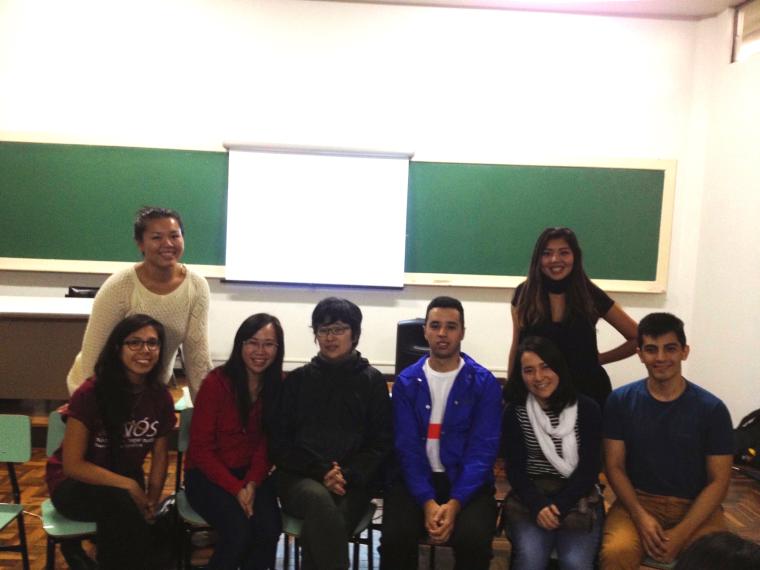Studying Race in Brazil
May 25, 2016
Kasey Cheydleur

Li (left) and Yamashiro (right) with their interviewees at the Racialeyes e-book pre-launch event
Photo credit: Laura Li
While studying and teaching through a Fulbright Fellowship in Brazil, Laura Li ’14 noticed in discussions about race that the conversation was limited to black and white, leaving out the complexities surrounding the Asian diaspora and other minorities like the indigenous people of Brazil.
Although Li had studied abroad previously in Ecuador, she said she was not prepared for the situation surrounding the Asian diaspora in Brazil. “In Brazil, political correctness does not exist in the same way as it does in the United States. Brazilians live in a ‘postracial democracy’ so comments on race are read as jokes or teasing. So, there were many instances in which people would pull their eyes at me and would refer to me as ‘japa’ when my heritage is not Japanese; would call my eyes ‘puxados,’ meaning ‘pulled’ or ‘pulled back’; and many other things that I would consider microaggressions or even aggressions,” she says. Knowing fellow Fulbright Scholar Mia Yamashiro shared the same frustrations, the two decided to cofound Racialeyes, a multimedia project specifically pertaining to the Asian community in Brazil.
Li explains that the Racialeyes project draws its name from the verb “racialize” and the idea that eyes are often what isolate people of Asian descent and mark them as “other.” Li and Yamashiro recorded 14 interviews with people of Asian descent spanning four generations, and subsequently published an e-book available in both English and Portuguese. They have also released a promotional video and survey to gather more information about the effects beauty standards may have on the perceptions of different eye types.
Coordinating so many personal narratives can be a complicated process, and Li credits a travel writing course she took with Professor of Rhetoric and Composition Laurie McMillin for helping her learn to think about storytelling and character development from multiple perspectives. “We had so much flexibility and creative license to build a story, and in order to do that we had to dig deep and think about how we interacted in the spaces we were in abroad. I had to think about my identity and the many other cultural and societal factors at play and how they structured my experiences—which may be very different than another person going through the same experiences.” She says this approach has helped her tell the project participants’ stories in a structured, compelling way.
While at Oberlin, Li studied politics and was a member of the varsity field hockey team for four years and captain her senior year. She also worked as a tutor for America Reads, and participated in the Taiko ExCo, Asian American Alliance, Chinese Student Association, Student Athletic Advising Committee, and Oberlin College Democrats.
Looking to the future, Li is considering either working in education and developing curriculum for pluricultural education or attending law school with a focus on education or housing discrimination.
You may also like…
Josh Nolan Named Vice President, General Counsel, and Secretary at Oberlin
Distinguished attorney brings extensive experience in higher education law.
Learning by Teaching: Oberlin Students Share Global Music with Young Learners
College and Conservatory students in PACE 103 prepare local children for an immersive community concert at Oberlin.
Nuiko Wadden ’02 Joins Oberlin Conservatory Faculty as Assistant Professor of Harp
The versatile musician brings extensive opera, orchestral, and contemporary music experience to her role


